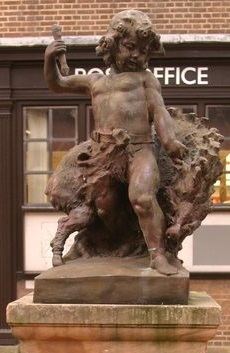A dryad (/ˈdraɪ.æd/; Greek: Δρυάδες, sing.: Δρυάς) is a tree nymph, or tree spirit, in Greek mythology. In Greek drys signifies "oak." Thus, dryads are specifically the nymphs of oak trees, though the term has come to be used for all tree nymphs in general. "Such deities are very much overshadowed by the divine figures defined through poetry and cult," Walter Burkert remarked of Greek nature deities. They were normally considered to be very shy creatures, except around the goddess Artemis, who was known to be a friend to most nymphs.
The dryads of ash trees were called the Meliai. The ash-tree sisters tended the infant Zeus in Rhea's Cretan cave. Gaea gave birth to the Meliai after being made fertile by the blood of castrated Uranus. Nymphs associated with apple trees were the Epimeliad, and those associated with walnut-trees were the Caryatids.
Dryads, like all nymphs, were supernaturally long-lived and tied to their homes, but some were a step beyond most nymphs. These were the hamadryads who were an integral part of their trees, such that if the tree died, the hamadryad associated with it died as well. For these reasons, dryads and the Greek gods punished any mortals who harmed trees without first propitiating the tree-nymphs. (associated with Oak trees)
Some of the individual dryads or hamadryads are:
Atlanteia and Phoebe, two of the many wives or concubines of DanausChrysopeleiaDryopeEratoEurydicePhigaliaPitysTithoreaIn the arts and culture
Dryads are mentioned in Milton's Paradise Lost, in the works of Coleridge, and in Thackeray's novel The Virginians. Keats addresses the nightingale as "light-winged Dryad of the trees", in his "Ode to a Nightingale". In the poetry of Donald Davidson they illustrate the themes of tradition and the importance of the past to the present. The poet Sylvia Plath uses them to symbolize nature in her poetry in "On the Difficulty of Conjuring up a Dryad", and "On the Plethora of Dryads".Secret of Mana, an action role-playing game released for the Super NES, features a magical spirit named Dryad. He is a tree-like creature who provides Earth-based magic when summoned.The Dryad appears as a neutral demon in the Megami Tensei video game series.In the ballet Don Quixote, dryads appear in a vision with Dulcinea before Don Quixote. They also appear in the classical ballet Sylvia.The story "Dear Dryad" (1924) by Oliver Onions features a dryad influencing several romantic couples through history.Dryads are also featured extensively throughout The Chronicles of Narnia by British author C.S. Lewis and are shown to fight alongside Aslan, son of the Emperor-Over-The-Sea, and the Pevensie children.Dryades Street is a major thoroughfare in the city of New Orleans, running parallel to the former Nyades Street (now St. Charles Avenue).Sibelius wrote a symphonic poem called "The Wood Nymph" (Opus 15).A character from a 2005 CGI animated film Barbie: Fairytopia named Dahlia, is said to be a dryad. She is depicted living in a tree and having a pair of wings.A Non Player Character in the 2011 action-fantasy survival game Terraria. She is a merchant who possesses magical powers. She specialises in selling seeds and other nature related goods.
